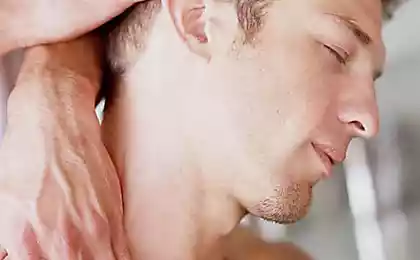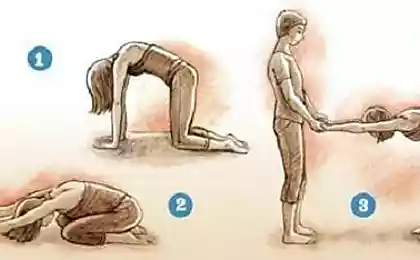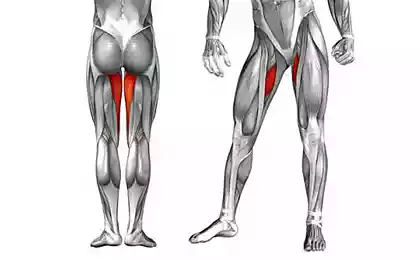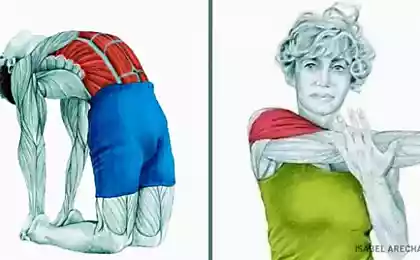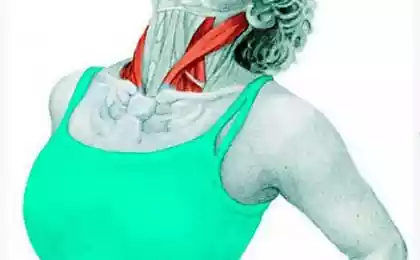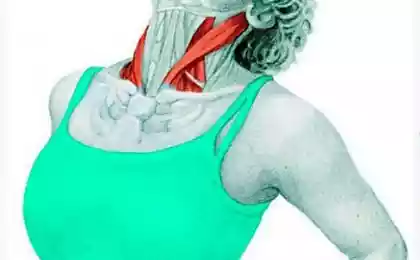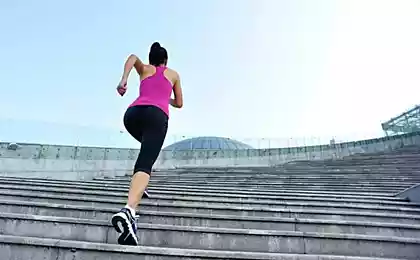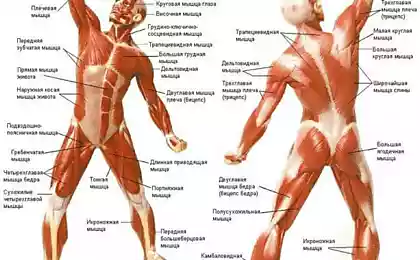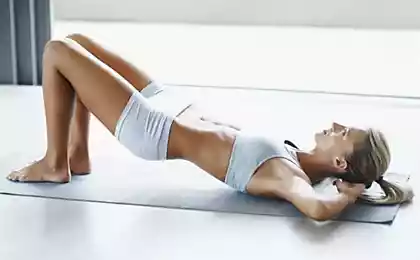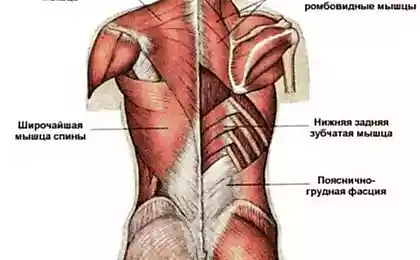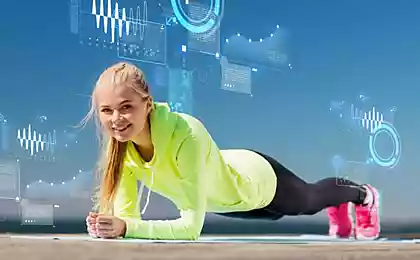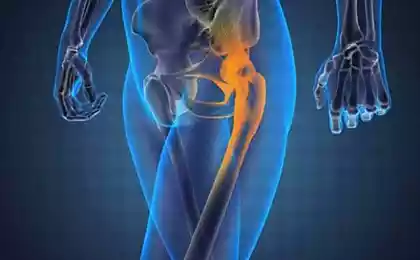645
Exercises post isometric relaxation: in just 3 minutes — try it now!
This method effects on your own muscle is hard to overestimate!
One who once felt it – will never forget! Right now ... Three minutes... Try it...
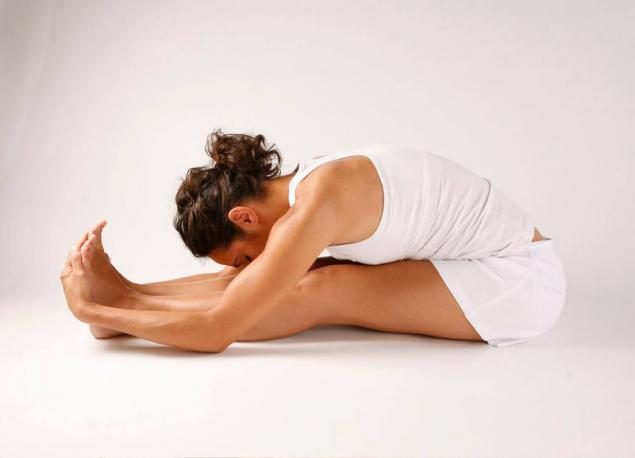
The question arises: "Why is this happening?" Can we in this mechanism a bit to understand.
Once the technique of relaxation of muscles based on the use of spinal reflexes inhibition, was first approved in spastic paresis of the American rehabilitation Hermann Cabot in the mid-50s. Later, this principle has found application in the methods of manual medicine and was described from a physiological point of view as post isometric muscle relaxation (PIR).
This is the most simple and effective method of relaxing muscles is activated, the minimum power followed by an automatic "powerful" reflex inhibition. This physiological mechanism. It was on this principle is based relaxing effect morning "pothouses" when You are happy, just waking up, "sweet" I reach up and stretch, saying the sacramental phrase: "to sleep..." it has a deep meaning, which is carried out by us unconsciously.
In other words, when a tense muscle will work a bit, then she relaxes and rests.
It should be recalled that the signal to work any muscle it gets from "his" motor center, which is located in the so-called "motor cortex" of the brain. And these "commanders" for all muscles are located in one place. When you inhale tense the main muscle of breathing (one of the most powerful) – diaphragm, aktiviziruyutsya its motor centre. Like ripples from a stone thrown in the water, the excitation spreads to other motor centers lying around in this area of the brain. The result – all the skeletal muscles that control our movements from the smallest to the largest aktiviziruyutsya and slightly raise your tone. As if waiting for the team to action. We are ready to "roll". This phenomenon is called synergism.
Then, when breathing out the reverse action. Initial deceleration of the center of the diaphragm and, accordingly, friendly braking all the other motor centres. Muscles effectively relax. This is the rhythm of life.
It also happens that one or more of the muscles have to be in constant tension, fixing the problematic joint or protecting the inflammation. And then, regardless of the breathing, the muscle is constantly working outside of our consciousness. So can take weeks and months. Then it will start to hurt. Characteristic for such a long strain of pain – aching, as "a nail in the back", "number blocked", baking, as a brick on the back, heavy. In this case we can speak about the so-called fibrosis of the muscle fibers.
Let me explain. The fibrosis is a process of gradual replacement of muscle fibers to the connective tissue fibers. Muscle can shrink and change their length, and connective tissue – no! Muscle does not fibrosarcoma ALL. But only areas or in one place. This place is felt by the fingers through the skin as skiers painful at pressing the ball.
Permanent muscle tension the body must spend energy. But why do that if you already have, for example, a year as there are no active movements in the muscle. The function of contraction and relaxation is not performed and as it is not needed. So gradually replaced with the moving fabric is stationary.
This process is lengthy. And reverse the healing process – not too fast. You need to make some independent efforts to implement special stretching isometric exercises (PIR) + massage. It all depends on the conditions on the ground.
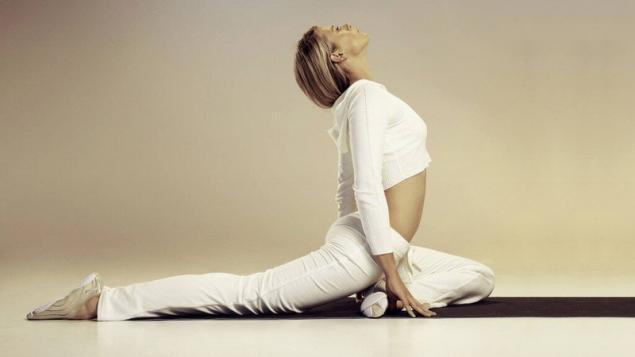
Actually how to do it
If relaxation and subsequent stretching are not enough, the phase of muscle tension (isometric) of breathing can slightly increase (up to 30 seconds).
Usually after the third second isometric phase of the exercise, you may notice that the voltage literally "melts".
One muscle group you must run about 10 cycles of tension and relaxation.
The most convenient and work properly with exercise together with an instructor or a physiotherapist. You strain a muscle, holding my breath, and the instructor then it stretches and locks in the new position.
But some very important muscle groups for problems, especially in the lower back – can and should be able to do yourself.
Using this principle, you can stretch and relax any muscle or group of muscles.

G. A. by Ivanicheva – a student of Professor V. P. Veselovsky developed method posticipate relaxation of the muscles. In some cases it works even better than post isometric relaxation. It differs from the PIR is as follows: after a phase of tension (as in the previous case), it is necessary to stretch the muscle. But this is not an instructor to your stress and the patient, which strains the muscles-antagonists perform the opposite stretch muscle work. The role of the instructor during the pause is to control the direction and the degree of activity of the antagonist.
A. G. chechenin has proposed a modification of the PIR methodology posterization relaxation of the muscles: after a phase of isometric contraction to strengthen the postisometric relaxation phase, the instructor squeezes the soft tissue to a slight pain in the location of the antagonist muscles.
Stretching is a specific exercise designed to stretch musicnotation structures and contributing to the increase in volume of movements in joints. There are two main methods of stretching:
Synergistic mechanisms are widely used in kinesiotherapy for the activation of muscle function in Central and peripheral motor disorders. Using electromyography found that almost 100% of skeletal muscles one way or another are involved in friendly response. While nearby muscles are characterized by relatively high activity, relatively low and distant.
Many of the well-known fact that if you go on the road and look ahead, then go straight. And when you look back or look over the shoulder in any direction, the initial rate of traffic on the road is also deflected in the same direction. This is a synergy of muscles.
According to EMG studies, the normal background synergistic muscle activity does not exceed 10% of the amplitude to arbitrarily reduce muscle. However, in some cases it is possible to detect extremely efficient friendly response, a reflex in which the tension synergists are often superior in strength, initiating muscle contraction.
In manual medicine, widespread respiratory and oculomotor synergy, which usually combined with the feast and appear most useful when exposed on the muscles of the neck, shoulders and chest. If You want to turn to the right, look in the same direction the eyes, and You will succeed.
Yy popelyansky described the so-called fixational synergy - involuntary activity of the muscles of the waist and abdomen, arising from an arbitrary stress or muscle contractions of the pelvis, and extremities, due to the need of fixation of the lumbar spine. Its essence can be explained with the following example: if You're straining in the supine position legs (bend them in the knee or hip joints), the reflex tension of the muscles of the lower back and abdominal muscles will far surpass the power of arbitrarily shrinking of the muscles of the legs.
Now about the "fix" muscle to "hold back".

The method of progressive training (bodybuilding) was originally developed by athletes bodybuilders. Currently, it is used everywhere not only in sports but also in medicine, in cases when you want to increase endurance, strength or volume of the muscle, delay atrophy of muscle tissue and also to stimulate the formation of new muscle fibers.
Immediately I say. Not in all cases, this tactic is suitable. For example, in the presence of the circular protrusion of lumbar disks with considerable loss of moisture by the disc these exercises with incorrect weights can cause further destruction of the structure of the disk and more serious consequences.
The basisof bodybuilding is the process of building and shaping muscles through systematic training, including multiple repetitions of relatively simple exercises with increasing weights. It is important that the weights were small, otherwise after only a few repetitions will occur "phenomenon victimize" in the form of substitutive compensation from unused muscle groups.
On the other hand, lifting a very heavy load, the muscles still are not able to mobilize (use) all your fibers. Only the repeated lifting of small goods provides consistent replacement of fatigued muscle fibers are fresh, allowing you to "work through" the entire volume of the muscle.
Each exercise is performed in a few "approaches" that includes a series of reps (8-12 for upper body and 12-15 for legs) performed "to failure", that is, as long as the muscles will be unable to do at least one more repetition (if you do less than 6 repetitions develops strength, and if more 15 - muscle endurance). Followed by a short rest, and describes additional approaches. Maybe 15-20 approaches in various exercises for this body part.
After the muscle was worked hard, she needs to give time for rest and growth. Muscle grows when resting, so should not work the same body part two days in a row. Sooner or later the muscles will adapt to consistent practice and their further development is slowed.
Initially increase the load by increasing the number of reps in each set, in the future, begin to reduce rest pauses between sets. To increase the weight of the weights should be gradual and not more than 14 kilograms of the original.
Exercise should be done at a slow pace, especially the first two or three repetitions, without jerks and delays. You need to focus on those muscles that are involved in performing this exercise. The best results are achieved when the highest possible amplitude of movements.
All training program should take no more than 30-45 minutes.
Also interesting: 5 exercises to restore the spine by Bragg
Exercise “Golden fish” for the spine, Katsudzo Niche
"Pleasant" muscle soreness after a workout indicates the high quality of training. It is well removed, sauna and massage.
In cases of intense pain, you should take a break for two days for this muscle group or to exercise with less weight.
Unfortunately the "problem" muscles, as a rule, are the most resistant to training and growing slower than the rest.published
Author: Dr. Vladimir R. R.
Source: www.spinanebolit.com.ua/menus/view/postizometricheskaya_relaksatciya_-_pir
One who once felt it – will never forget! Right now ... Three minutes... Try it...
- Sit on the floor and slowly reach hands to feet. There will come a time when "below" to lean hard. This so-called "elastic" barrier stretching muscles.
- Fix it! Don't move anymore. Without changing the position of the body, make the maximum deep breath and don't breathe for 10 seconds (about yourself, keep reading). Do not change the position of the body!
- And then exhale... the most relaxed, You will feel that you can lean on. Like "released" in a bend. And this will be Your first discovery.
- With each repetition of this exercise, You will be able to lean more and more forward...
- Further – more. The muscles that You were not allowed to bend forward – no longer will prevent this. And this will remain the case for long.
- Main mistake if you wish to stretch the muscle – snatch stretching. Sharply try to stretch you can not, or will inevitably be followed by a spasm and thus, You will make yourself worse.

The question arises: "Why is this happening?" Can we in this mechanism a bit to understand.
Once the technique of relaxation of muscles based on the use of spinal reflexes inhibition, was first approved in spastic paresis of the American rehabilitation Hermann Cabot in the mid-50s. Later, this principle has found application in the methods of manual medicine and was described from a physiological point of view as post isometric muscle relaxation (PIR).
This is the most simple and effective method of relaxing muscles is activated, the minimum power followed by an automatic "powerful" reflex inhibition. This physiological mechanism. It was on this principle is based relaxing effect morning "pothouses" when You are happy, just waking up, "sweet" I reach up and stretch, saying the sacramental phrase: "to sleep..." it has a deep meaning, which is carried out by us unconsciously.
In other words, when a tense muscle will work a bit, then she relaxes and rests.
It should be recalled that the signal to work any muscle it gets from "his" motor center, which is located in the so-called "motor cortex" of the brain. And these "commanders" for all muscles are located in one place. When you inhale tense the main muscle of breathing (one of the most powerful) – diaphragm, aktiviziruyutsya its motor centre. Like ripples from a stone thrown in the water, the excitation spreads to other motor centers lying around in this area of the brain. The result – all the skeletal muscles that control our movements from the smallest to the largest aktiviziruyutsya and slightly raise your tone. As if waiting for the team to action. We are ready to "roll". This phenomenon is called synergism.
Then, when breathing out the reverse action. Initial deceleration of the center of the diaphragm and, accordingly, friendly braking all the other motor centres. Muscles effectively relax. This is the rhythm of life.
It also happens that one or more of the muscles have to be in constant tension, fixing the problematic joint or protecting the inflammation. And then, regardless of the breathing, the muscle is constantly working outside of our consciousness. So can take weeks and months. Then it will start to hurt. Characteristic for such a long strain of pain – aching, as "a nail in the back", "number blocked", baking, as a brick on the back, heavy. In this case we can speak about the so-called fibrosis of the muscle fibers.
Let me explain. The fibrosis is a process of gradual replacement of muscle fibers to the connective tissue fibers. Muscle can shrink and change their length, and connective tissue – no! Muscle does not fibrosarcoma ALL. But only areas or in one place. This place is felt by the fingers through the skin as skiers painful at pressing the ball.
Permanent muscle tension the body must spend energy. But why do that if you already have, for example, a year as there are no active movements in the muscle. The function of contraction and relaxation is not performed and as it is not needed. So gradually replaced with the moving fabric is stationary.
This process is lengthy. And reverse the healing process – not too fast. You need to make some independent efforts to implement special stretching isometric exercises (PIR) + massage. It all depends on the conditions on the ground.

Actually how to do it
- Before you begin, decide what muscle or muscle group You want to stretch. View the position in which the muscle is most stretched, and in which the shortened (reduced). Starting position – stretching the muscles to "elastic" barrier. Without efforts. Further if the pull will be uncomfortable or painful.
- This provision is necessary to fix, take a deep breath, hold breath for 10 seconds and without changing the length of the muscle (by blocking it), a little strain in the direction of reduction (reduce the length). Stress on the muscle tension is about 5% of the maximum possible.
- Then do a full relaxed exhale, gradually removing the force for muscle contraction. After waiting a few seconds, and making sure the muscle is really relaxed, it slowly for 10-15 seconds, stretch further without resistance; this is a new position for stretching. It is fixed and the cycle repeats.
If relaxation and subsequent stretching are not enough, the phase of muscle tension (isometric) of breathing can slightly increase (up to 30 seconds).
Usually after the third second isometric phase of the exercise, you may notice that the voltage literally "melts".
One muscle group you must run about 10 cycles of tension and relaxation.
The most convenient and work properly with exercise together with an instructor or a physiotherapist. You strain a muscle, holding my breath, and the instructor then it stretches and locks in the new position.
But some very important muscle groups for problems, especially in the lower back – can and should be able to do yourself.
Using this principle, you can stretch and relax any muscle or group of muscles.

G. A. by Ivanicheva – a student of Professor V. P. Veselovsky developed method posticipate relaxation of the muscles. In some cases it works even better than post isometric relaxation. It differs from the PIR is as follows: after a phase of tension (as in the previous case), it is necessary to stretch the muscle. But this is not an instructor to your stress and the patient, which strains the muscles-antagonists perform the opposite stretch muscle work. The role of the instructor during the pause is to control the direction and the degree of activity of the antagonist.
A. G. chechenin has proposed a modification of the PIR methodology posterization relaxation of the muscles: after a phase of isometric contraction to strengthen the postisometric relaxation phase, the instructor squeezes the soft tissue to a slight pain in the location of the antagonist muscles.
Stretching is a specific exercise designed to stretch musicnotation structures and contributing to the increase in volume of movements in joints. There are two main methods of stretching:
- ballistic - flapping hands and feet, and flexion and extension of the body, performed with a high amplitude, and acceleration (the main tensile forces is inertia and gravity);
- static - stretching of the concerned muscle groups has been very slow movements performed at a constant speed, while the patient assumes a particular posture or gives a certain position of the limbs, save for 10-30 or even 60 seconds.
Synergistic mechanisms are widely used in kinesiotherapy for the activation of muscle function in Central and peripheral motor disorders. Using electromyography found that almost 100% of skeletal muscles one way or another are involved in friendly response. While nearby muscles are characterized by relatively high activity, relatively low and distant.
Many of the well-known fact that if you go on the road and look ahead, then go straight. And when you look back or look over the shoulder in any direction, the initial rate of traffic on the road is also deflected in the same direction. This is a synergy of muscles.
According to EMG studies, the normal background synergistic muscle activity does not exceed 10% of the amplitude to arbitrarily reduce muscle. However, in some cases it is possible to detect extremely efficient friendly response, a reflex in which the tension synergists are often superior in strength, initiating muscle contraction.
In manual medicine, widespread respiratory and oculomotor synergy, which usually combined with the feast and appear most useful when exposed on the muscles of the neck, shoulders and chest. If You want to turn to the right, look in the same direction the eyes, and You will succeed.
Yy popelyansky described the so-called fixational synergy - involuntary activity of the muscles of the waist and abdomen, arising from an arbitrary stress or muscle contractions of the pelvis, and extremities, due to the need of fixation of the lumbar spine. Its essence can be explained with the following example: if You're straining in the supine position legs (bend them in the knee or hip joints), the reflex tension of the muscles of the lower back and abdominal muscles will far surpass the power of arbitrarily shrinking of the muscles of the legs.
Now about the "fix" muscle to "hold back".

The method of progressive training (bodybuilding) was originally developed by athletes bodybuilders. Currently, it is used everywhere not only in sports but also in medicine, in cases when you want to increase endurance, strength or volume of the muscle, delay atrophy of muscle tissue and also to stimulate the formation of new muscle fibers.
Immediately I say. Not in all cases, this tactic is suitable. For example, in the presence of the circular protrusion of lumbar disks with considerable loss of moisture by the disc these exercises with incorrect weights can cause further destruction of the structure of the disk and more serious consequences.
The basisof bodybuilding is the process of building and shaping muscles through systematic training, including multiple repetitions of relatively simple exercises with increasing weights. It is important that the weights were small, otherwise after only a few repetitions will occur "phenomenon victimize" in the form of substitutive compensation from unused muscle groups.
On the other hand, lifting a very heavy load, the muscles still are not able to mobilize (use) all your fibers. Only the repeated lifting of small goods provides consistent replacement of fatigued muscle fibers are fresh, allowing you to "work through" the entire volume of the muscle.
Each exercise is performed in a few "approaches" that includes a series of reps (8-12 for upper body and 12-15 for legs) performed "to failure", that is, as long as the muscles will be unable to do at least one more repetition (if you do less than 6 repetitions develops strength, and if more 15 - muscle endurance). Followed by a short rest, and describes additional approaches. Maybe 15-20 approaches in various exercises for this body part.
After the muscle was worked hard, she needs to give time for rest and growth. Muscle grows when resting, so should not work the same body part two days in a row. Sooner or later the muscles will adapt to consistent practice and their further development is slowed.
Initially increase the load by increasing the number of reps in each set, in the future, begin to reduce rest pauses between sets. To increase the weight of the weights should be gradual and not more than 14 kilograms of the original.
Exercise should be done at a slow pace, especially the first two or three repetitions, without jerks and delays. You need to focus on those muscles that are involved in performing this exercise. The best results are achieved when the highest possible amplitude of movements.
All training program should take no more than 30-45 minutes.
Also interesting: 5 exercises to restore the spine by Bragg
Exercise “Golden fish” for the spine, Katsudzo Niche
"Pleasant" muscle soreness after a workout indicates the high quality of training. It is well removed, sauna and massage.
In cases of intense pain, you should take a break for two days for this muscle group or to exercise with less weight.
Unfortunately the "problem" muscles, as a rule, are the most resistant to training and growing slower than the rest.published
Author: Dr. Vladimir R. R.
Source: www.spinanebolit.com.ua/menus/view/postizometricheskaya_relaksatciya_-_pir



